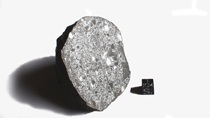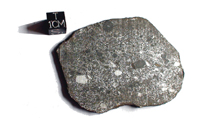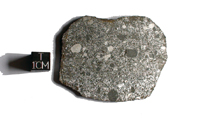Mesosiderites
The mesosiderites are named for the Greek words mesos for
"middle" or "half", and sideros for "iron",
meaning "half iron". In fact, they are typical stony-iron
meteorites, consisting of approximately equal portions of nickel-iron
metal and silicates. Excluding all probable pairings, the mesosiderite
group comprises about 50 distinct members, while seven members represent
witnessed falls.
Texturally, mesosiderites are a complex mixture of a nickel-iron metal
portion and a heavily brecciated silicate portion, consisting of mostly
pyroxene and plagioclase. Strangely, the silicates are obviously evolved
igneous rocks, representing the crust of an achondritic parent body. They
are quite similar to eucrites, diogenites, and other members of the HED
group, even plotting on the same oxygen isotope fractionation line.
However, the metal in mesosiderites is similar to group IIIAB irons,
obviously representing the core of a distinct, differentiated asteroid,
genetically unrelated to the precursor of the eucritic and diogenitic
portion. This suggests a complex formation history for the mesosiderites
and their parent body. One theory has them formed by the collision of two
differentiated asteroids, allowing the still liquid core of one asteroid
to mix with the solidified crust of the other. This scenario includes the
collisional disruption and gravitational reassembly of at least one of the
asteroids - the one that later became the parent body of the mesosiderites.
It is still heavily debated whether the HED parent body, 4 Vesta, actually
represents one of these asteroids.
Based on textural and mineralogical differences, the mesosiderites have
been divided into four distinct groups that were further divided into
subgroups. These groups are designated 1A, 1B, 2A, 2B, 2C, 3A, 3B, 4A, and
4B. However, there seems to be no scientific consensus about this
classification scheme, as it has been differently interpreted by different
researchers. To avoid any confusion, we won't elaborate on this matter.
Famous members of the mesosiderite group are the witnessed falls of
Estherville, Iowa, USA, in 1879, and Lowicz, Poland, in 1935. Another
renowned member is Vaca Muerta, a find from Chile. Several hundred
individuals of this well-preserved mesosiderite have been recovered from
its strewn field in the Atacama Desert, making it the most common
mesosiderite in private and public collections. >>
top...
|
NWA 4747
Northwest Africa 4747
TKW : 1200 gr from Morocco
Found: 2001- Mesosiderite
|
|
|
 
|
|
|
|
NWA 4747
512 gr
the main mass !!! superb specimen
Price
on request |
|
|
|
|
|
|
|
NWA 4747-01
Superb full slice
40.95 gr
SOLD
|
|
|
|
  |
|
|
|
|
|
|
 
|
|
|
|
NWA 4747-02
Superb full slice
30.65 gr
Price
on request |
|
|
|
|
|
|
|